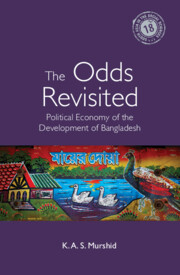Book contents
- Frontmatter
- Dedication
- Contents
- List of Tables and Figures
- Acknowledgements
- List of Abbreviations
- Introduction
- 1 A Bird’s-Eye View of the Bangladesh Economy: 1971–2020
- 2 Initial Conditions: The Odds Revisited
- 3 The Food Security Challenge
- 4 Exploring Transition and Change in the Rice Market
- 5 International Migration
- 6 The Rural Non-farm (RNF) Sector
- 7 Industrialization and the Rise of RMG
- 8 Industrialization: Other Stories
- 9 The Social Sector Puzzle
- 10 Dhaka: Capital Formation—Urbanization, Competition and the Rise of a Business Class
- Conclusion
- Notes
- Glossary
- References
- Index
5 - International Migration
Published online by Cambridge University Press: 30 June 2022
- Frontmatter
- Dedication
- Contents
- List of Tables and Figures
- Acknowledgements
- List of Abbreviations
- Introduction
- 1 A Bird’s-Eye View of the Bangladesh Economy: 1971–2020
- 2 Initial Conditions: The Odds Revisited
- 3 The Food Security Challenge
- 4 Exploring Transition and Change in the Rice Market
- 5 International Migration
- 6 The Rural Non-farm (RNF) Sector
- 7 Industrialization and the Rise of RMG
- 8 Industrialization: Other Stories
- 9 The Social Sector Puzzle
- 10 Dhaka: Capital Formation—Urbanization, Competition and the Rise of a Business Class
- Conclusion
- Notes
- Glossary
- References
- Index
Summary
At the same time that Bangladesh was struggling with the GR, a silent process of migration was already afoot – a beginning which would eventually gather steam and take off. In 1976, only 6,000 workers left for the Middle East for work but by 1981 this rose to around 56,000. Other countries in Asia, including Pakistan, India, Sri Lanka, Nepal, Thailand and Philippines, were able to respond more quickly to the dramatic opening up of labour markets in the oil-rich Middle East following the lifting of the oil embargo in 1973 and a surge in the petrodollar economies of the Gulf and Saudi Arabia. Thus, the number of Indians sent out in 1976 was around 4,000 but this figure grew to over 275,000 in 1981. In the case of Pakistan, the figure for 1976 was less than 42,000, which went up to over 168,000 in 1981 (Arnold and Shah 1986).
The slower initial response rate from Bangladesh may have been due to labour market preferences or more likely due to the poor institutional arrangements and high migration costs in Bangladesh compared to competing countries. Bangladesh in the mid-1970s was a country that was still struggling with the aftermath of war and famine. Migration rates, nevertheless, picked up quickly but spiked in 1991–95 and 2006–10, the latter including the global financial crisis period. In fact, only during 2011–15 we observe a 12 per cent drop in outmigration, which appears to be related to the 8 per cent decline in remittance growth in the subsequent period (Table 5.1).
Migrant remittances continue to play a big role in a number of Asian countries including Bangladesh, helping to strengthen the BOP and shore up foreign exchange reserves while also having an impact on rural households in terms of income, consumption, savings and investment. A related impact of remittances, historically, has been its timing – gaining ascendance at a time when donor fatigue was setting in, putting aid-dependent countries like Bangladesh at considerable risk (Rodríguez 2020). For example, for Bangladesh, remittance earnings comprised 40 per cent of exports and 5.7 per cent of GDP in 2018. In fact, the comparative figures for a number of countries like Nepal, Sri Lanka, Pakistan and Philippines are higher (Table 5.2).
- Type
- Chapter
- Information
- The Odds RevisitedPolitical Economy of the Development of Bangladesh, pp. 78 - 83Publisher: Cambridge University PressPrint publication year: 2022



